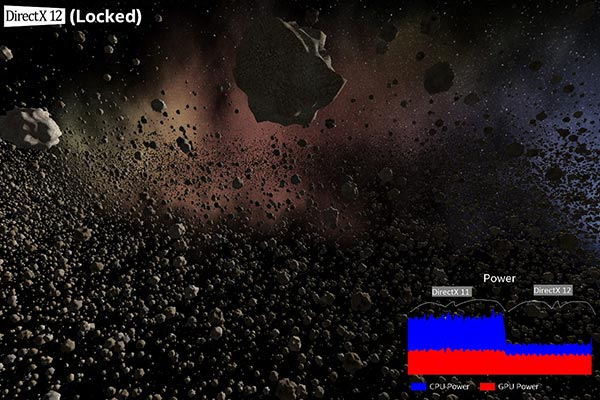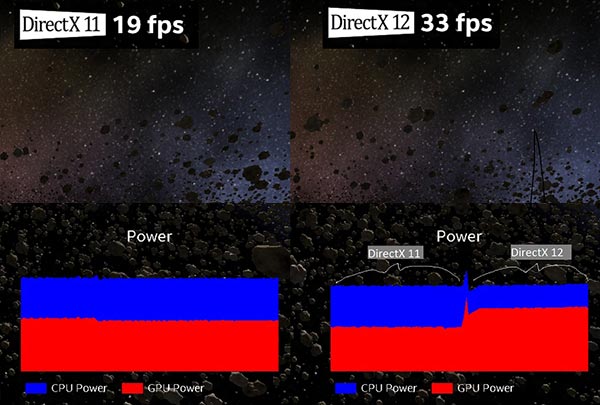Intel is one of the first companies to publically demonstrate the advances Microsoft's DirectX 12 brings to its graphics hardware. At Siggraph 2014 Chipzilla showed a graphics demo which was switched between using the DirectX 12 and Direct3D 12 APIs and the older DirectX 11 ones on a Microsoft Surface Pro tablet employing an Intel Core i5 processor with Intel HD4400 graphics.
A demo program which showed an asteroid field, made up of about 50,000 of these celestial bodies, was used to demonstrate the potential power savings and/or FPS boost that can be achieved thanks to DirectX 12. We have embedded a couple of screens from the Intel blog post which show this asteroid field running in either power (saving) or (high) performance modes. Please look at the graph in the lower right hand corners of the images to see the comparative enhancements.

Power savings
In a comparison with the frame rate locked at an easily achievable FPS you can see the drastic cut in power consumption when DirectX 12 is toggled into play (above). Intel says that the same scene being rendered with DirectX12 "uses less than half the CPU power when compared to DirectX 11, resulting in a cooler device with longer battery life".
The Intel blog explains that DirectX 12 usage results in both a "reduced graphics submission overhead," and "an increase in multithreaded efficiency".

Performance boost
At another extreme of DirextX12 implementation Intel uses the API to squeeze the maximum performance from the asteroid demo – at the thermal and power constraints of the platform. The simple result, on the Surface Pro 3, is an FPS boost of about 70 per cent. That's from 19fps to 33fps - as pictured above. Interestingly you can see the balance of workload shifting towards the integrated GPU under DirectX 12.
Intel concludes that, while its demos show two extremes of application, developers will probably choose a compromise between these contrasting philosophies. "The main takeaway is that power and performance are inseparably linked," wrote Intel's Andrew Lauritze. "Conventional notions of 'CPU vs. GPU bound' are misleading on modern devices like the Surface Pro 3. An increase in CPU power efficiency can be used for more performance even if an application is not 'CPU bound'."
Remember that DirectX 12 will be very important to tablet and mobile games and not just on actively cooled gaming PCs so thermal and power constraints will be increasingly important.













